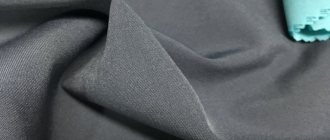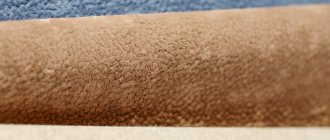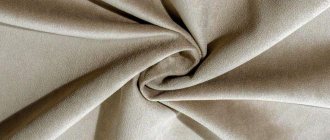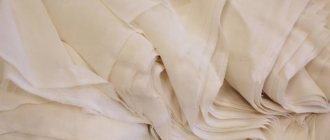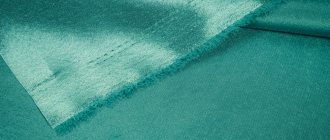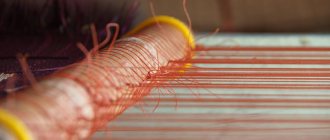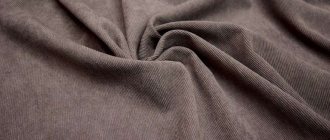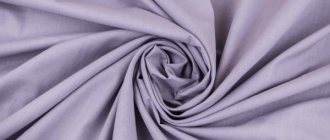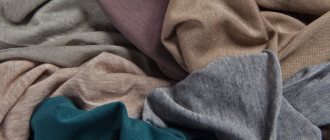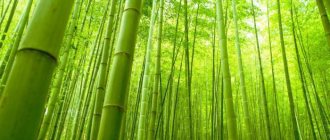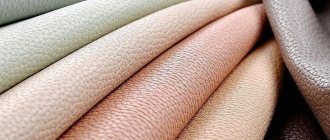The following are techniques and tips for working smoothly with thick fabrics such as denim, heavy wool, gabardine and twill . The description below is based on denim , but will work for any thick fabric.
What you will need
- Needle for denim size 90-110
- Polyester threads (No. 40-80)
- Straight stitch
- Universal foot
Cotton
Thick cotton fabric can be made either 100% from natural raw materials or with the addition of artificial and synthetic fibers. The range of such materials is very wide; the most famous and popular are the following fabrics, obtained in various weaves:
- Twill.
It is produced with a diagonal weave, so on the front surface it has a pronounced diagonal pattern or a small herringbone rib. Twill fabric is characterized by wear resistance, strength and durability. It is used for sewing trousers, suits, workwear, curtains, and demi-season outerwear. - Moleskin.
Produced in a very dense satin weave with reinforced weft and warp threads. This is a smooth, hygroscopic, comfortable fabric, most often dyed dark. Moleskine is resistant to wear, friction and other deformations, is easy to clean and does not electrify. It is used for sewing workwear for hazardous industries, trousers and outerwear. - Velveteen.
Fabric with small or large longitudinal rib. Its name translates as “royal cloth”. This is a material with a luxurious appearance, soft, durable and almost wrinkle-resistant. Retains heat well, but requires maintenance and can shrink. Demi-season and children's clothing, trousers, and dresses are produced from ribbed fabric. Often used for sewing curtains, bags and hats. - Poplin.
A finely ribbed fabric formed by thickened weft threads. Can be painted in a wide variety of colors and patterns. Soft, durable, breathable and inexpensive material with a slight sheen. High hygroscopic properties make it possible to use poplin for the production of curtains, bed linen, casual clothing and home textiles. - Tale.
Soft fabric with pile on the reverse side. Retains heat well and hardly stretches. It is used to make children's and casual clothing. - Jeans.
Can be made using one of the twill weave types. This is a durable fabric that allows moisture to pass through and retains heat. There may be a small inclined or vertical scar on the surface. Used for sewing jeans, outerwear, shoes and bags. - Pique.
Its popular variety is called waffle fabric. The weave, which forms a pattern on the surface in the form of small honeycombs or diamonds, can be brushed on the reverse side. The fabric has an original appearance and excellent hygienic properties. This soft, practical fabric is used for sewing polo shirts, dresses and skirts, home textiles and children's clothing. - Jacquard.
Thick fabric based on linen or cotton raw materials. It has a dense structure with a relief surface. Wear-resistant, easy to care for, attractive in appearance and durable fabric.
Using a combination of cotton and artificial or synthetic fibers, fabrics with completely different characteristics can be obtained. The weaves used are the same as for pure cotton.
Processing the bottom of jeans
When hemming the hem, remove as much excess fabric as possible to avoid excess thickness. After sewing the side seams on the legs, iron the seam allowances, pressing firmly with the iron to unroll the layers of fabric. At future seam intersections, trim the edges of the seam allowances at an angle to reduce the thickness of the hem.
Trimming seam allowance corners before double hemming
Typically, jeans are double hemmed with stitching .
Having determined the length of the future pant leg, fold the fabric twice at the hem allowance and press. Make sure the hem width is the same around the entire circumference of the leg, for example, using a ruler to mark the seam allowance. Press down firmly where the seams join the front and back halves of the jeans and secure the edges with pins or small clothespins.
In this example, the width of the first hem is 1.5 cm, the width of the second hem is 2 cm. Before making the seam, the hem is fixed with clothespins
The bottom thread will be visible on the right side of the hem, so prepare a bobbin with the threads you want to show on the face. Typically, topstitching thread is used as the bottom thread. For convenience, open the “free sleeve” on the machine. Use regular polyester thread as the top thread and a denim needle of at least size 100.
Bobbin with Mettler No. 30 twisted thread wound on it
Get a presser foot that will make the job easier, such as one with a guide that allows you to maintain distance from the hem around the entire circumference of the pant leg.
Select a straight stitch by increasing the stitch length to 3.5mm. Increase the tension of the upper thread a little so that the lower thread is well stretched on the front side, make a test stitch on a piece of fabric.
After adjusting the stitching, place the trouser leg under the presser foot with the wrong side facing up. Sew along the top fold so that the needle passes through all layers of fabric that form the hem. Process the bottom of the second leg.
The hem is sewn from the inside of the trouser leg. Here the seam is made using a double feed system and a guide foot
Finished hems: front and back
Simple hem seam
If the classic hem method creates too much thickness for your sewing machine, use a simple hem stitch.
To deal with thick layers of fabric, use an old needle pack or buy a thick fabric plate (tight spot plate). This accessory allows you to compensate for the difference between thicknesses, in particular when processing the bottom of jeans. By raising the presser foot, this plate helps the machine cope with the difference in height created by multiple layers of fabric.
Different plates for difficult places
When the foot reaches a large thickness, leave the needle inside the fabric, lift the foot and place a needle pack or plate under it. Make sure that the presser foot rests completely on the plate. Lower the presser foot: now it is at the desired height, in a stable position and does not bounce, so the seam is even (photo 1). Continue sewing and remove the plate as soon as the foot is no longer resting on its surface.
Photo 1
Twin needle sewing
To perfectly create a double hem or double topstitch on denim or other thick fabric, use a special 4.0/100 denim twin needle. This way you can do double stitching on denim and any other thick fabric in one operation (about using a double needle).
Double needle for denim
Back pocket with double-needle hem and bartack
The same method is used to compensate for the end of the tissue thickening: the plates have a hole for a needle (photo 2).
Photo 2
These sewing techniques are useful for a variety of other materials.
Silk
Several types of materials with increased density are produced from durable and delicate silk thread. Thick silk fabric has the same shine and smooth surface as more airy options. It is worth considering that these materials do not have very great heat-shielding properties .
Satin is the most popular dense silk fabric. Made with satin weave. Satin has an extremely smooth and shiny surface. The back of the fabric is matte, with a slight roughness. The atlas is characterized by the following properties:
- good hygroscopicity;
- hypoallergenic;
- does not accumulate static electricity;
- excellent drapability;
- elasticity and lightness;
- strength;
- durability.
In addition, dust particles and small specks do not settle on the satin. The material is not of interest to insects, which means it will not harbor ticks or other pests. Satin does not wrinkle, and things made from it keep their shape well.
In addition to its advantages, completely natural satin also has disadvantages. This dense silk fabric is easy to care for: it requires hand washing in cold water with special products. The satin should not be wrung out or twisted so as not to disturb the structure of the fibers.
Most often, satin is not made entirely from silk threads. Cotton, viscose, polyester, nylon, and acetate are added to the fabric composition. This expands the scope of application of the fabric. Silk satin is used for sewing dresses, elegant and casual clothes, curtains, bags, underwear and bed linen. Satin with the addition of synthetic raw materials is used for finishing furniture and decorating residential premises.
The following materials containing silk have a dense structure:
- Velvet.
Made with pile weave. This is usually a wool blend or silk fabric with piles of different lengths. Mainly used for sewing and decorating furniture, curtains, shoes, bags. The front surface can be smooth or finely ribbed (corduroy). The length of the pile can also vary. - Taffeta.
Produced by simple weaving. It has a very smooth surface with a glossy shine. This thin but dense fabric is used for sewing shirts and dresses. - Moire.
As a result of calendering, a material with a wave-like sheen is obtained. Durable, well-draped fabric is used for sewing festive clothes, curtains and decor. - Shanzhan.
It is distinguished by a wave-like color tint, which is obtained by using threads of different colors or shades for the warp and weft. Both silk and cotton fibers can be used. This smooth material with a peculiar shine is used for sewing evening and festive items. - Reps.
This dense fabric is made with a complex plain weave, which forms a fine rib on the surface. An easy-to-care material used for sewing summer and mid-season clothing, curtains and home decor.
Less popular are silk fabrics such as chesucha, brocade, faille, dama, duchess. They are used to make theatrical, historical and evening dresses. Semi-natural fabrics are used for sewing curtains, shoes, and bags.
Linen
The most common dense linen fabrics include:
- Crinoline.
Linen fabric with increased rigidity and density. Used as a cushioning material to give shape to clothing items. - Canvas.
Made from thick yarn, often treated with a water-repellent compound. Workwear, shoes, and bags are made from it. - Teak.
A striped fabric used for upholstery. - Matting.
Made with double or triple weave. Used for sewing everyday clothes.
In most cases, dense fabric made from linen yarn is used for sewing workwear and interior decoration.
Origin story
Sackcloth or burlap has a long history. We can say that this is the very first fabric that man learned to make.
Previously, clothes were made from the material. Initially, it was inaccessible to the common people and was used to sew clothes for kings and wealthy people.
With the development of production, burlap became available to other segments of society. Currently, it is used to make packaging material or some decorative items.
Wool
Most wool fabrics have increased strength.
Dense wool fabric is a leader in heat-protective properties among natural fabrics.
Most often in light industry the following types of materials are used:
- Gabardine.
Made from twisted merino yarn. There is an inclined scar on the front surface. Wear-resistant fabric with a matte surface and good heat-shielding properties. This easy-to-care material has excellent drapability and hygienic properties. It is used for sewing outerwear and casual clothing, curtains, decor and workwear. - Tartan.
Woolen or wool blend fabric in a checkered pattern, also called “tartan”. Dense and warm material that is used for sewing outerwear, casual and national clothing, blankets and bedspreads. - Tweed.
Soft material made with a diagonal weave. There is a small pile on the surface. Elastic, almost wrinkle-resistant fabric with high heat and water protection properties. Outerwear, suits, skirts, and trousers are made from it. - Flannel.
Blended wool, wool or brushed cotton fabric with an inconspicuous scar on the surface. Due to its softness, it is used for the manufacture of children's and home clothing, bed linen. - Covercott.
Produced with twill weave from twisted threads. Elastic and warm fabric is used for sewing outerwear, suits and other everyday items.
In addition, the following materials are common:
- loden;
- tapestry;
- boucle;
- drape;
- cloth;
- Cheviot etc.
Other materials
Dense fabrics may include artificial and synthetic fibers and threads. Increased density is achieved mainly due to reinforced weaves.
Knitwear can also be dense if it is made from thick yarn, knitted in a double or triple weave, or has a thick pile, brushed or complex pattern . Thick cotton knitwear is called interlock. The loops of the fabric intersect, which provides additional density and strength. This is a material smooth on both sides, with excellent thermal insulation and hygroscopic properties. This knitwear has almost no stretch and is resistant to wear and deformation. It is used for sewing children's, sports, home and casual clothing.
Footer is knitwear, also made from cotton. There is a slight comb on the back side, while the front surface is smooth and dense. This knitwear has high hygienic and performance characteristics. It is used for children's, home and sportswear.
Jersey is a knitwear product formerly made from wool or containing a large amount of it. Now it is made from a wide variety of threads and fibers. This knitwear does not wrinkle, it only stretches in width. Jersey is a soft and pleasant to the touch material. Knitwear is used depending on its composition. Woolen jersey is used for sewing outerwear and warm clothing. Cotton knitwear is the basis for making children's and home clothes, silk is used for underwear.
Fabric preparation
First of all, you need to take suitable needles for denim: thanks to the features of the point, they easily pass through fabrics with a dense weave of threads. Their rod is especially strong, which helps avoid sudden movements and breakage. In the absence of such needles, you can use universal ones, but of a larger size (for example, 100).
As for threads, those made from polyester are best - they are quite durable. The thread size can be from No. 40 to No. 80, depending on the size of the needle. Use the same threads for the bottom thread.
Denim needles
Denim, like gabardine, often needs to be stitched: stitching strengthens the seams and serves as a decorative element. Use twisted or regular threads in a contrasting or matching shade depending on the effect you want (about stitching).
Thick fabrics are processed with a straight stitch with a stitch length of 3-3.5 mm: such values ensure good material flow and make sewing easier. Start stitching slowly, gradually moving to medium speed. Avoid sudden movements of the needle: they can weaken and even break it.
Strengthening the seam
To reinforce seams that will be subject to repeated tension (crop seams on pants, seams on waistbands, bag handles, etc.), use a triple straight stitch (triple reinforced stitch). This reinforced stitching gives the seam greater strength.
On the left is a regular straight stitch, on the right is a triple straight stitch. Both are made with the same threads
Triple stitch
If the needle becomes more difficult to pass through the fabric as the number of layers increases, try sewing the stitch by gently rotating the handwheel. You can also raise the needle and presser foot as much as possible and move the fabric back a few millimeters: this way the needle will find a better path for itself - where there are fewer layers. In all these cases, replace the needle with a larger needle as soon as possible - all these difficulties indicate that the needle is too small.
Reducing the thickness of fabric layers
Whatever the chosen tool (iron, hammer, rolling pin), maximizing the thickness of the layers makes working with thick fabrics much easier. You can also use a roller foot: a roller at the front of the presser foot rolls out the fabric before the needle pierces.
As for presser feet, a straight stitch foot or a universal foot will do. You may need to reduce the presser foot pressure to make the sewing process easier. And for even better material feeding, you can use a walking foot or use the dual material feeding system if your machine has one.
This Pfaff brand machine uses a double material feed system (behind the presser foot)
Consider elasticity
Some thicker fabrics have a little elastane added to make them stretch and comfortable to wear. When sewing, it is important not to stretch or deform the fabric: let the machine move the material itself.
